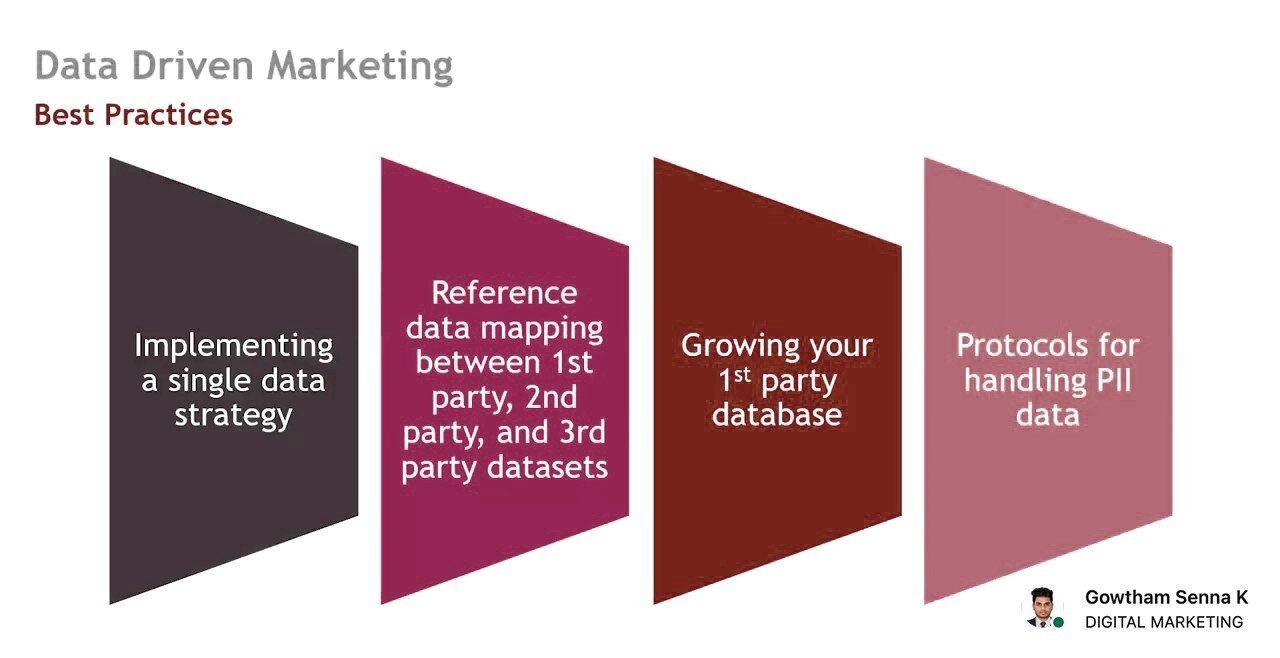
Building a Data-Driven Marketing Strategy: Best Practices
Posted on March 7, 2024
In the modern marketing landscape, data is the backbone of effective strategy development. By utilizing data to inform decisions, businesses can create personalized, targeted campaigns that resonate with the right audience. A data-driven marketing strategy empowers businesses to make smarter decisions, optimize resources, and improve return on investment (ROI).
Here’s a comprehensive guide to building a data-driven marketing strategy using best practices:
1. Define Clear Objectives
Before diving into data collection and analysis, it’s essential to define your marketing goals. Clear objectives allow you to focus on collecting the right data and measure success effectively. Your goals might include:
- Increasing website traffic
- Boosting conversions
- Improving customer retention
- Enhancing brand awareness
These goals should be aligned with your business objectives and help you understand the metrics that matter most.
2. Collect Relevant Data
The next step is to gather the right data. To build a robust data-driven strategy, you need data from various touchpoints and channels. Some key sources of data include:
- Website Analytics: Track user behavior, page views, bounce rates, time on page, etc.
- Social Media Analytics: Measure engagement, impressions, clicks, and audience demographics.
- CRM Systems: Capture customer data, sales funnels, and customer lifecycle.
- Email Campaign Metrics: Monitor open rates, click-through rates (CTR), and conversions from email campaigns.
- Third-Party Data: Use market research, surveys, and competitor analysis for a broader perspective.
Using a variety of data sources ensures that your insights are comprehensive and well-rounded.
3. Leverage Advanced Analytics Tools
To effectively analyze the data, marketers need to use the right tools. Analytical platforms and software, such as Google Analytics, HubSpot, and Tableau, can provide actionable insights from large datasets.
Tools like predictive analytics and machine learning algorithms can help forecast trends, customer behavior, and sales, enabling you to make more informed decisions.
4. Segment Your Audience
One of the key advantages of data-driven marketing is the ability to segment your audience. By analyzing customer behavior and demographics, you can create distinct audience segments and tailor your marketing efforts to each segment’s specific needs and preferences.
For example, if you have a product that appeals to different age groups or geographic regions, data can help you personalize your campaigns to resonate with each group. The more granular the segmentation, the more relevant and targeted your marketing will be.
5. Personalize Your Campaigns
Data enables you to create highly personalized experiences for your customers. By analyzing behavioral data, you can craft messages that speak directly to individual needs and interests. Personalization can take many forms:
- Personalized Email Campaigns: Send tailored offers or content based on previous customer interactions.
- Dynamic Website Content: Show different website content based on visitor segments, location, or behavior.
- Targeted Ads: Use behavioral and demographic data to run customized ad campaigns on platforms like Facebook, Google, or LinkedIn.
Personalized campaigns are proven to increase customer engagement, loyalty, and conversion rates.
6. Optimize Campaigns in Real Time
One of the advantages of using data in marketing is the ability to optimize campaigns in real-time. With real-time insights, you can assess the performance of your marketing activities, identify what’s working, and make adjustments immediately.
If a particular ad isn’t resonating with your audience, you can tweak the messaging, change the targeting, or even pause the campaign altogether. Real-time optimization helps you avoid wasting resources on ineffective strategies and continuously improve performance.
7. Measure and Analyze Performance
Measurement is essential for any data-driven strategy. Without continuous tracking and analysis, it’s impossible to know whether your strategy is working. Use Key Performance Indicators (KPIs) aligned with your business objectives to measure success.
Some essential KPIs include:
- Conversion Rate: Measures the percentage of visitors who complete a desired action.
- Customer Acquisition Cost (CAC): Tracks the cost of acquiring a new customer.
- Customer Lifetime Value (CLTV): Measures the total revenue a customer will generate over their relationship with your brand.
- Return on Investment (ROI): Measures the profitability of your marketing campaigns.
By tracking and analyzing these metrics, you can understand which areas of your marketing strategy are performing well and which need improvement.
8. Continuously Learn and Adapt
Data-driven marketing is an ongoing process. As you collect more data and your audience evolves, it’s essential to keep learning and adapting your strategy. Stay on top of trends, be open to new insights, and be ready to pivot when necessary.
Testing and experimentation, like A/B testing, can help you uncover new opportunities and optimize your campaigns for better results. Learn from both successes and failures to keep refining your approach and maximize your marketing effectiveness.
9. Ensure Data Quality and Privacy
One of the most important aspects of a data-driven strategy is ensuring data accuracy and compliance with privacy regulations. Poor-quality data can lead to flawed insights and ineffective campaigns. Regularly clean and validate your data to maintain its accuracy.
Additionally, ensure that you’re adhering to data privacy regulations such as GDPR, CCPA, or other applicable laws. Transparency in data collection and handling builds trust with your customers and ensures long-term success.
Conclusion
A data-driven marketing strategy allows businesses to make informed decisions, drive personalized experiences, and achieve greater marketing effectiveness. By collecting the right data, using analytics tools, personalizing campaigns, and continuously measuring performance, you can create a marketing strategy that resonates with your audience and delivers impactful results.
Remember, building a data-driven strategy is an iterative process. As you gather more insights and refine your approach, your marketing efforts will become increasingly effective, helping your brand stay ahead of the competition.
